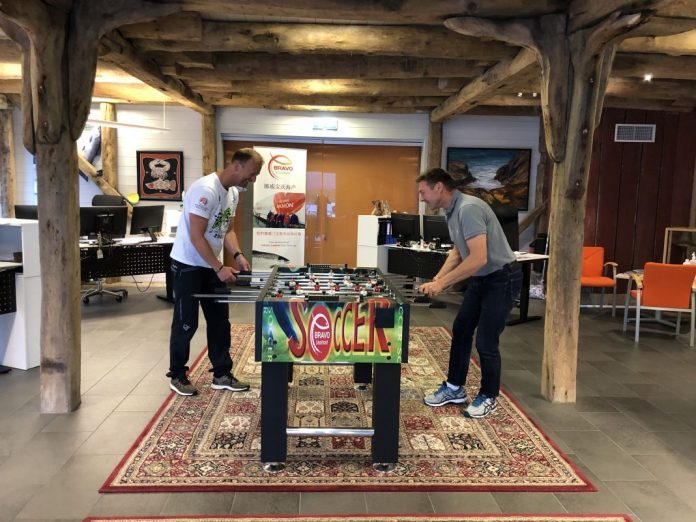Exporter preparing for challenging autumn.
The ancient herring town in Florø, Western Norway, has long since found a new species and a new locomotive to drive export revenues and employment. The harbour is full of wellboats, workboats, delousing vessels and cages.
One of those that capitalises on the farmed salmon is the 130 million-dollar exporter Bravo Seafood. They are housed in a traditional red-painted sea storage room at the quayside in the town’s harbour.
Challenges
Although they have delivered strong export growth for a number of years, Bravo also has experienced the effect of Covid-19.

“Our customers have had challenges. We didn’t escape either,” Bravo salesman and founder Svein Bruheim told SalmonBusiness.
“We are seeing changes in customer patterns – there are other types of customers who accept the fish. Larger processors are left selling to the supermarkets. The HORECA market is almost gone,” explained CEO Karl Petter Myklebust.
“It has recovered a little bit now in the summer, but now it’s coming back a little bit, and it will probably give its effect,” Bruheim said of the coronavirus impact.
“Asia really picked up very well this spring, but now Asia is down. Hong Kong is partly out, Taiwan, China – there’s hardly any sales. Much less in Asia.”
Must forget
Part of the explanation for the Asia issues was the discovery of Covid-19 on a salmon cutting board in a fish market in Beijing. Since then, the authorities have gone out and denied that farmed salmon is a source of the virus.
“It’s going to pass, but it’ll take its time. Consumers have to forget. It’s going to take months,” said Myklebust.
It can be argued that in the times of corona-virus, small export volumes have been seasonally out, and from August/September high volumes will be released into a weak market. Will it break the market?
“I don’t think so,” said Bruheim. “But it is clear that you see the effect there is on the price now. If there’s more volume, it’s usually the theory of demand that kicks in.”
Can you get the fish placed at reasonable prices?
“Yes, it’s turned out that we can do it then,” he said.
‘There’s been more going on for the supermarkets. There are many who are taking the chance and the who freeze in. They may be earlier to run a larger share of production now instead of taking it further out in the autumn when they’ll make finished goods. But it’s going to be the acid test,” said Myklebust.
Weak krone
“But it’s all right then, for the industry. Okay, you’ve had an unusually weak krone that has helped,” Bruheim admitted.
“It was quite weak at its worst, otherwise it has been quite stable. There is a price now that many people can live with.”
Bravo also exports “a lot” of trout. There, prices are not as favourable. At least not for the fish farmers.
“It’s varying then, depending on the market, but I’ve heard NOK 32-33 (EUR 3-3.1),” said buyer and mountaineer Håkon Åsvang. “They are struggling with orders, it’s an order drought.”
“Europe has not been a success for trout. Wrong name? Trout, that’s basically the Danish trout. It is not as positively charged as the salmon. There may be some marketing work that may have been wrong. Maybe it’s so simple that it’s the wrong name for it. The product is fantastic,” said Bruheim.

In the freezer
“Trout is a negative or low-cost commodity. They’re struggling with it in Asia, too. They deserve higher prices. It’s a great product,” said Myklebust.
“But either way, there is a vanishing little trout make up of the salmon product. Five or six per cent? I’m glad we’ve got a little bit in the freezer. Both here and there,” said Bruheim.
There is a lot, both trout, salmon and coho, in the freezer in Chile at the moment.
“It should worry a lot, I think,” said Myklebust.
“Yes, there’s a backdrop here. There’s a lot coming to Europe from Chile. It’s sold at a euro lower for the C-trim,” Bruheim added.
“It’s when they have liquidity problems, then it comes out more easily,” he added.
But both are clear on rejecting that there is any crisis in the market.
“Production is stable. There’s no increase to talk about. It seems that demand for salmon is increasing,” said Myklebust.
“It is a pity that the biomass has to be reduced here in the area, by five or six per-cent. It’s defiant,” Bruheim said.
“It’ll have ripple effects for many – for processors, exporters, suppliers,” said Myklebust. “But it’s going reasonably smoothly. We have increased export volume. We sell the most to Western Europe, we have a little bit on Asia. Asia is not a huge market, but it is important to us.”


